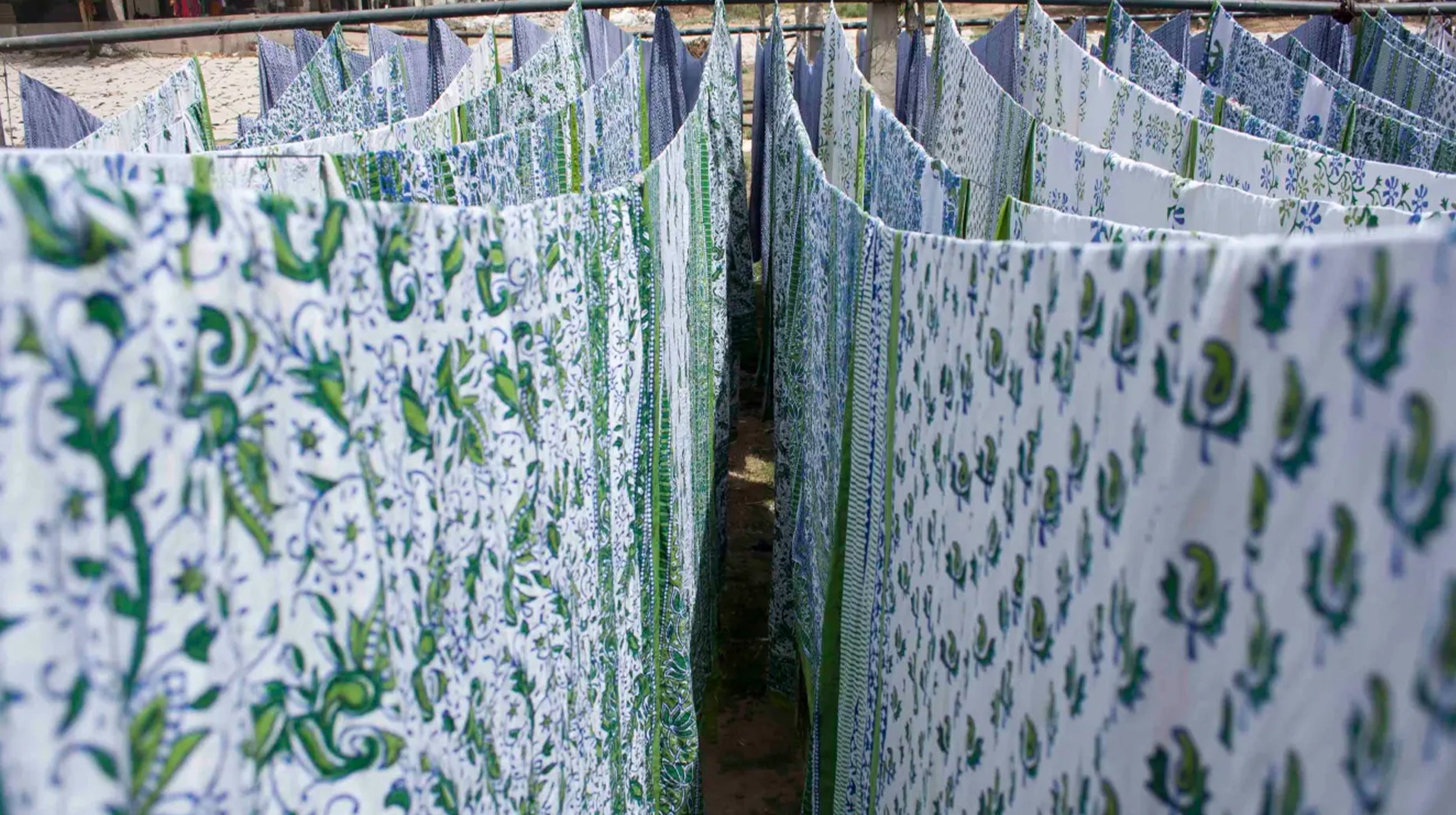The Deep Palette of Ajrakh
Ajrakh hand-block printing has its origins in the regions of Sindh, which is now part of present-day Pakistan, and the Kutch district in Gujarat, India. The craft has a shared history between the regions of Sindh and Kutch, and both areas have contributed significantly to the development and preservation of Ajrakh printing techniques.
Ajrakh is a traditional form of hand-block printing that holds deep roots in the rich textile heritage of India. Originating in the regions of Gujarat and Rajasthan, Ajrakh has been practiced for centuries, and its name is derived from the Arabic word "Azrak," meaning blue. The craft involves a meticulous process of block printing on fabric using natural dyes and intricate geometric patterns. They echo the symmetrical beauty found in nature, encapsulating stars, grids, and floral motifs that hold deeper meanings within various communities and rituals.
This ancient craft involves a detailed and artisanal process, bringing fabric to life through the intricate practice of hand-block printing. Artisans, often inheriting skills across generations, transform cloth into a canvas of cultural richness. What distinguishes Ajrakh is not only its technique but also the use of natural dyes derived from plants and minerals. These organic hues, spanning from indigo blues to earthy reds and yellows, infuse vitality into the fabric, creating a distinct and vibrant color palette.

The depiction illustrates the Ajrakh artisans from Gujrat.
Why Ajrakh Features Limited Motifs and Patterns
Ajrakh holds profound cultural and historical importance, with its limited motifs serving as carriers of specific cultural narratives and symbols, preserving the craft's authenticity. The intricate and time-consuming nature of Ajrakh printing benefits from a restricted motif selection, enabling artisans to master precise designs. Each motif in Ajrakh bears symbolic significance, and the limited repertoire allows for a deeper exploration of these symbols, transforming each piece into a canvas of storytelling. Rooted in a heritage passed down through generations, Ajrakh's restricted motifs contribute to the preservation of the craft's integrity and traditional designs. The use of natural dyes, while limiting color options, aligns with the craft's commitment to sustainable practices. The deliberate selection of motifs in Ajrakh reflects a harmonious balance between cultural heritage, artisan expertise, and the constraints of natural dyeing.
Preparation of Dyes and Printing Process
Natural dyes for Ajrakh prints are meticulously derived from plant-based sources, minerals, and organic materials, with common contributors like indigo, madder, pomegranate, and turmeric. Each raw material undergoes a detailed process – indigo leaves are fermented for an indigo vat, while madder roots are boiled to release red hues. Mordants, such as alum or iron, fix the colors to the fabric, ensuring lasting vibrancy.
The extracted colors are thoughtfully blended by artisans to achieve the desired palette for Ajrakh prints. The fabric is immersed in the dye bath, and skilled artisans use resist techniques like block printing with a resist paste or tying and folding to create intricate patterns.
Post-dyeing, the fabric undergoes oxidation when exposed to air, a crucial step for dyes like indigo to develop their final color. Subsequent washing removes excess dye and mordants. In the case of Ajrakh, known for its multicolored allure, the fabric may go through multiple cycles of dyeing, resist printing, and washing, contributing to the creation of intricate, layered patterns.

Significant use of Geometrical patterns
The prevalence of geometric patterns in Ajrakh holds both aesthetic and cultural significance. These patterns, characterized by intricate designs and symmetrical arrangements, are not only visually appealing but also deeply rooted in cultural symbolism. Geometric shapes, such as stars, grids, and floral motifs, often carry profound meanings within various communities and traditions.
The deliberate use of these patterns allows Ajrakh artisans to convey stories, convey cultural narratives, and pay homage to age-old traditions. Furthermore, the precision and regularity of geometric patterns align seamlessly with the block printing technique used in Ajrakh, facilitating the creation of intricate and consistent designs. The significant use of geometric patterns in Ajrakh, therefore, becomes a harmonious blend of artistic expression, cultural symbolism, and the technical demands of the craft.
‘Churrai’ or Fabric Washing
In the local communities, the term "Churrai" encapsulates the cleansing ritual integral to the Ajrakh-making process. The fabric undergoes an initial wash and beating to eliminate dirt and impurities. Subsequently, it is immersed in a unique solution comprising soda bicarbonate and oil. This process, though slightly intricate, requires a span of a few days for completion.

The depiction illustrates the Ajrakh artisans carrying out the Churrai process.
Ancient and Modern era
In ancient times, Ajrakh prints found their prominence on headscarves, turbans, and shawls, encapsulating the traditional wardrobe of bygone communities. Fast forward to the contemporary era, and the ingenious touch of modern designers has breathed new life into this age-old craft. Now, Ajrakh techniques are skillfully employed to craft a diverse array of captivating silhouettes, including kurtas, scarves, dupattas, sarees, skirts, and pants. This creative evolution goes beyond mere printing, incorporating intricate ornamentation such as gota and sequin work, adding a touch of glamour to Ajrakh garments. The remarkable revival of Ajrakh in recent decades stands as a testament to its enduring charm, seamlessly blending tradition with innovation in the ever-evolving landscape of fashion.

